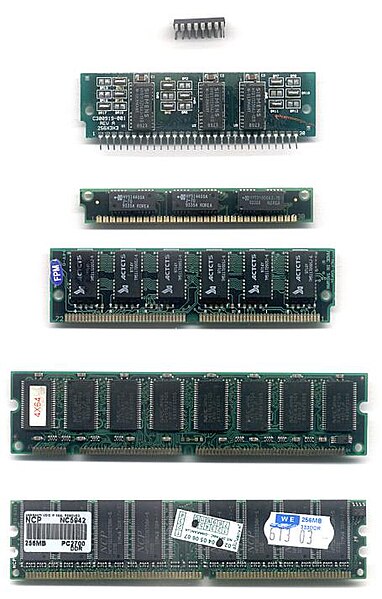Learning Resources
Memory Packaging
Like processors, memory is made from tiny semiconductor chips and must be packaged into something less fragile and tiny in order to be integrated with the rest of the system. However, in many cases the chip packages are themselves further integrated into larger packages. There are many different kinds of memory packages in the PC world today, and it can be difficult to know which type needs to be used with a given system design. This section discusses the types of packaging available and the issues involved in selecting and using memory packages and DRAM chips in a PC.
Memory is available in various physical packaging. Roughly in order of their appearance, the major types of DRAM packaging include:
DIP (Dual Inline Pin Package)
This package comprises a rectangular chip with a row of pins down each long side, making it resemble an insect. DIP was the most common DRAM package used in PCs through early 386 models. DIP chips were produced in Page Mode and Fast Page Mode, and are long obsolete. DIP packaging was also used for L2 cache memory on most 486 and some Pentium-class motherboards. DIP DRAM is useless nowadays.
SIPP (Single Inline Pin Package)
This package turns a DIP chip on its side and extends all leads straight out one side, parallel to the plane of the chip. SIPPs were intended to allow memory to be installed more densely, and were used in a few 386SX systems, but they never caught on. SIPPs were produced in Page Mode and Fast Page Mode form, and are long obsolete.
SIMM (Single Inline Memory Module)
This package mounts multiple individual DRAM DIP chips on a small circuit board with a card-edge connector designed to fit a socket on the motherboard. Mainstream SIMMs have been manufactured in two form factors:
30-pin
These SIMMs were used in a few 286 systems, most 386 systems, and some 486 systems, and were produced in Page Mode and Fast Page Mode form. Although they are still available, 30-pin SIMMs are obsolete. If you tear down an old system, any 30-pin SIMMs you salvage are too small and too slow to be useful. However, some laser printers do use them.
72-pin
These SIMMs were used in some 386 systems, most 486 systems, and nearly all Pentium-class systems built before the advent of DIMMs. 72-pin SIMMs were produced in Fast Page Mode, EDO form, and BEDO form. When tearing down old systems, 72-pin SIMMs may be worth salvaging, as they can be used to expand the memory on a late-model Pentium or Pentium Pro system or to expand the memory in some laser printers.
As shown in the image -


